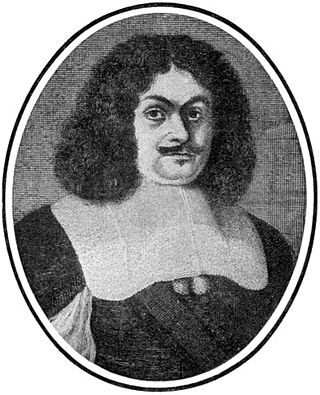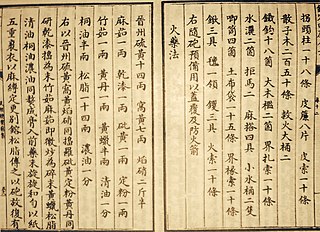
Alchemy is an ancient branch of natural philosophy, a philosophical and protoscientific tradition that was historically practised in China, India, the Muslim world, and Europe. In its Western form, alchemy is first attested in a number of pseudepigraphical texts written in Greco-Roman Egypt during the first few centuries AD. Greek-speaking alchemists often referred to their craft as "the Art" (τέχνη) or "Knowledge" (ἐπιστήμη), and it was often characterised as mystic (μυστική), sacred (ἱɛρά), or divine (θɛíα).

Gunpowder, also commonly known as black powder to distinguish it from modern smokeless powder, is the earliest known chemical explosive. It consists of a mixture of sulfur, charcoal, and potassium nitrate (saltpeter). The sulfur and charcoal act as fuels while the saltpeter is an oxidizer. Gunpowder has been widely used as a propellant in firearms, artillery, rocketry, and pyrotechnics, including use as a blasting agent for explosives in quarrying, mining, building pipelines, tunnels, and roads.

An arquebus is a form of long gun that appeared in Europe and the Ottoman Empire during the 15th century. An infantryman armed with an arquebus is called an arquebusier.

Ludwig Anzengruber was an Austrian dramatist, novelist and poet. He was born and died in Vienna, Austria.

In an explosive, pyrotechnic device, or military munition, a fuse is the part of the device that initiates function. In common usage, the word fuse is used indiscriminately. However, when being specific, the term fuse describes a simple pyrotechnic initiating device, like the cord on a firecracker whereas the term fuze is used when referring to a more sophisticated ignition device incorporating mechanical and/or electronic components, such as a proximity fuze for an M107 artillery shell, magnetic or acoustic fuze on a sea mine, spring-loaded grenade fuze, pencil detonator, or anti-handling device.

Johannes Liechtenauer was a German fencing master who had a great level of influence on the German fencing tradition in the 14th century.

Codex 3227a of the Germanisches Nationalmuseum in Nuremberg is a manuscript of 169 folia, dated to the close of the 14th century. Its text is written in Latin and German. The German portions have been identified as in East Central German dialect.

Andreas Gryphius was a German poet and playwright. With his eloquent sonnets, which contains "The Suffering, Frailty of Life and the World", he is considered one of the most important Baroque poets of the Germanosphere. He was one of the first improvers of the German language and German poetry.

The hand cannon, also known as the gonne or handgonne, is the first true firearm and the successor of the fire lance. It is the oldest type of small arms, as well as the most mechanically simple form of metal barrel firearms. Unlike matchlock firearms it requires direct manual external ignition through a touch hole without any form of firing mechanism. It may also be considered a forerunner of the handgun. The hand cannon was widely used in China from the 13th century onward and later throughout Eurasia in the 14th century. In 15th century Europe, the hand cannon evolved to become the matchlock arquebus, which became the first firearm to have a trigger.

Heinrich Khunrath, or Dr. Henricus Khunrath as he was also called, was a German physician, hermetic philosopher, and alchemist. Frances Yates considered him to be a link between the philosophy of John Dee and Rosicrucianism. His name, in the spelling "Henricus Künraht" was used as a pseudonym for the 1670 publisher of the Tractatus Theologico-Politicus of Baruch Spinoza.

Gunpowder artillery in the Middle Ages primarily consisted of the introduction of the cannon, large tubular firearms designed to fire a heavy projectile over a long distance. Guns, bombs, rockets and cannons were first invented in China during the Han and Song dynasties and then later spread to Europe and the Middle East during the period.

Gunpowder is the first explosive to have been developed. Popularly listed as one of the "Four Great Inventions" of China, it was invented during the late Tang dynasty while the earliest recorded chemical formula for gunpowder dates to the Song dynasty. Knowledge of gunpowder spread rapidly throughout Asia and Europe, possibly as a result of the Mongol conquests during the 13th century, with written formulas for it appearing in the Middle East between 1240 and 1280 in a treatise by Hasan al-Rammah, and in Europe by 1267 in the Opus Majus by Roger Bacon. It was employed in warfare to some effect from at least the 10th century in weapons such as fire arrows, bombs, and the fire lance before the appearance of the gun in the 13th century. While the fire lance was eventually supplanted by the gun, other gunpowder weapons such as rockets and fire arrows continued to see use in China, Korea, India, and this eventually led to its use in the Middle East, Europe, and Africa. Bombs too never ceased to develop and continued to progress into the modern day as grenades, mines, and other explosive implements. Gunpowder has also been used for non-military purposes such as fireworks for entertainment, or in explosives for mining and tunneling.

The first rockets were used as propulsion systems for arrows, and may have appeared as early as the 10th century in Song dynasty China. However, more solid documentary evidence does not appear until the 13th century. The technology probably spread across Eurasia in the wake of the Mongol invasions of the mid-13th century. Usage of rockets as weapons before modern rocketry is attested to in China, Korea, India, and Europe. One of the first recorded rocket launchers is the "wasp nest" fire arrow launcher produced by the Ming dynasty in 1380. In Europe, rockets were also used in the same year at the Battle of Chioggia. The Joseon kingdom of Korea used a type of mobile multiple rocket launcher known as the "Munjong Hwacha" by 1451.

A gun is a device designed to propel a projectile using pressure or explosive force. The projectiles are typically solid, but can also be pressurized liquid, or gas. Solid projectiles may be free-flying or tethered. A large-caliber gun is also called a cannon. Guns were designed as weapons for military use, and then found use in hunting. Now, there are guns, e.g., toy guns, water guns, paintball guns, etc., for many purposes.

The Waldsteinburg, also called the Red Castle is a ruined castle on the summit of the Großer Waldstein in the Fichtel Mountains of Germany. It is also known as the Westburg to distinguish it from the older ruins of the Ostburg.
This is a timeline of the history of gunpowder and related topics such as weapons, warfare, and industrial applications. The timeline covers the history of gunpowder from the first hints of its origin as a Taoist alchemical product in China until its replacement by smokeless powder in the late 19th century.

In the history of gunpowder there are a range of theories about the transmission of the knowledge of gunpowder and guns from Imperial China to the rest of the world following the Song, Jin and Yuan dynasties. The earliest bronze guns found in China date back to the 13th century, with archaeological and textual evidence for previous nascent gunpowder technology developed beforehand. Scholars note the scarcity of records for firearms in the Middle East prior to the mid-14th century, and in Russia before the late 14th century, yet cannons already appeared in Europe by the early 14th century. Less accepted theories include gunpowder as being independently invented in the Middle East or South Asia.

Bedil tombak or bedil tumbak is a type of early firearm from the Indonesian archipelago. The weapon consists of a gun or small cannon mounted on a wooden pole, forming a type of weapon known as "pole gun".

Josef Alois Knittel was an Austrian-born German sculptor. On his mother's side, he was a nephew of the painter, Joseph Anton Koch; on his father's side, an uncle of Anna Stainer-Knittel. His sons, Gustav Adolf and Berthold Knittel also became sculptors.
The Great Didactic, Comenius, John Amos, Adam & Charles Black, London, 1633/1907, p. 83


















